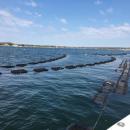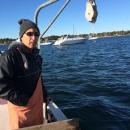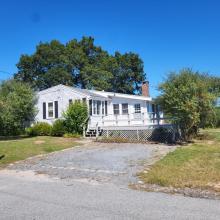The in's and out's of oyster farming, and how it affects Dartmouth's waters
Dartmouth’s shellfishing industry once stretched beyond Padanaram Harbor and into Slocum River and Little River. Pollution, limited coastline, and pricey upfront costs have stumped the town’s aquaculture scene, but renewed interest and updated regulations are helping to create a “win-win-win” for Dartmouth’s waters.
Prior to 2014, when Dartmouth awarded its first oyster farmer half an acre of the harbor, Dartmouth had no regulations for such an industry. Three years later, Steve Caravana is still Dartmouth’s only aquaculturist, but Harbormaster Steve Melo is working to change that.
“It’s great for the town. The water quality goes up. It puts Dartmouth on the map as a food source. It’s a job creator. It fits in with the farming industry, growing local and buying local. It’s unanimously seen as a win-win-win,” Melo said.
He’s currently working with 20-year-old Luke Sebesta, a University of Rhode Island student eager to turn his major in aquaculture into a family business. This summer, Sebesta bought his first boat — a 16-foot, 1970 Glasspar powerboat that he's named "Aw, Shucks!"
"It's kind of an antique, and it doesn't run yet," said Sebesta of his $1,900 investment. "I plan on shucking a lot of oysters on that boat."
The application process for farming oysters, however, is quite elaborate. It took Steve Caravana, owner of Padanaram Oyster Farm, nearly three years to get the go-ahead from federal, state, and local authorities.
Before Caravana received permitting in November 2014, there were no regulations for aquaculture in Dartmouth, which is part of the reason it took so long, explained Melo. He said once a proposed location is accepted, permitting takes about a year. But proposed farm sites must be okayed by conservation, zoning, and water traffic officials, and by the site’s abutters.
“The U.S. Army Corps of Engineers [which manages all waterways’ structures] wants to know what the impact would be. [The state Department of] Marine Fisheries looks to see if it’s an active harvest zone. The Conservation Commission looks to make sure it’s not an eelgrass habitat. The possession of [oyster] seed is managed by the state. We regulate [oyster farming] on the local level,” said Melo.
Sebesta’s first proposal for the northern Nonquitt Beach area has already been denied because of its eelgrass habitats. The floating oyster cages that he plans to use would block sunlight from reaching the photosynthesizers on the seafloor.
“That’s my major problem. It’s been eelgrass so far,” said Sebesta. “The permitting process is fairly difficult, especially in Dartmouth because we have a limited coastline. You have to avoid private property, avoid eelgrass, and avoid open waters where the weather can take equipment.”
Additionally, oyster farmers must have a minimum $100,000 liability insurance, in case their equipment breaks free during a storm and ends up damaging yards, docks, or boats, said Melo. Aquaculturists must also be town residents, mark the farm site with warning signs for passing boaters, and abide by the town’s noise regulations — which allows them to work between sunrise and sunset.
Undeterred, Sebesta is now eyeing a section off the southern end of Nonquitt Beach for his farm. He said the area should be far enough away from the usual boat traffic. If approved, Sebesta could begin executing his business plan.
“Seeing my dad had his own business, I wanted to do something along those lines, but I wanted to do my own thing. With my love for the ocean, I needed to do something out on the water,” he said.
Sebesta’s father, George, now 63 years old, runs George Sebesta Renovations. Sebesta works summers with his father, who has worked up to six days each week since 1979, Sebesta said.
“A lot of the farm is to help him out so maybe he could take some days off. He’s been working really hard to put me and my brother through school,” Sebesta said. The Slocum Road resident originally started at URI as a marine biology major, but wanting something more focused, he switched to aquaculture and fisheries after his first semester.
Until his own business takes off, Sebesta helps Caravana out on weekends.
As a full-time registered nurse for the state Department of Public Health, Caravana puts about 20 hours each week into his oyster farm. By 6 a.m., he launches his 21-foot boat — named “Kimberly Jean” after his wife — from Dias Landing, and sets off for his half-acre farm with homebrewed Dunkin Donuts coffee in hand.
He’ll spend two, six-hour days reshuffling the oyster population as it grows and cleaning his 90-cage operation, visible from Smith Neck Road. Mondays are reserved for harvesting and delivering his catch to Island Creek Oysters in Duxbury. In a week, he’ll harvest up to 2,000 oysters, each worth about 60-cents apiece, but it’s not all profit.
“The big challenge in this business is the unexpected breakdowns of things. I’ve learned a lot about investing the money where it needs to be,” said Caravana, naming trailers, ropes, and other gear. Cages cost about $44 each. Smaller oyster seed costs about $35 per 1,000, and bigger seed can run upward of $85 for 1,000, Caravana said.
Caravana’s farm operates with floating cages, but cages can also be set on the seafloor. Once he picks up the seed in the spring, he must get them into the water within 24 hours. Oystering can be done year-round, but below freezing temperatures hurt juveniles. Last season, Caravana harvested oysters through February, and has generally had a lot of luck growing in Padanaram Harbor.
“Typically you don’t see the growth that I see over here,” he said, adding that oysters typically take up to 18 months to mature. “I think it’s the body of water where I grow. It’s just loaded with nutrients,” he said.
Sebesta also plans to use floating cages for his company, although he has firsthand experience with both techniques after working with underwater cages last year at Rhode Island-based 401 Oyster Company.
“Floating aquaculture has been proven to have a lesser impact on the environment because it’s not directly interacting with the bottom,” explained Sebesta. Additionally, “higher growth rates have been seen because there’s generally more phytoplankton [which oysters feed on] in the first few feet of water because there’s more sunlight there,” he said.
Sebesta said floating cages are also easier to maintain. Cages constantly need to be cleared of seaweed and other blockages that prevent water from moving through, which affects oysters’ ability to feed.
Like traditional agriculture, weather and pollution can negatively affect the harvest. Last year’s algae bloom in Apponagansett Bay caused Caravana to miss out on six weeks of oystering.
If the oysters feed on the bloom, they can become infected with domoic acid, which has a nasty effect on a human’s nervous system if consumed, explained Caravana. Additionally, oyster farmers must be aware of Vibrio bacteria, a gastrointestinal infection sometimes caused by consuming raw seafood.
“Oysters have to be on ice within two hours of taking them out of the water,” said Sebesta. “You want to take a personal concern for it because you don’t want to get people sick.”
This is especially important for Sebesta, who hopes to eventually sell oysters right from his boat, similarly to Cuttyhunk Shellfish Farm’s “floating raw bar.” Additionally, a retail license generally increases profits for farmers, although they are hard to get because a refrigerator vehicle and clean processing plant are required, Caravana said.
Wholesale licenses allow farmers to sell their harvests to wholesalers, who then sell the crops to restaurants and grocers. Farmers see less of the profit with this middleman setup.
Although Sebesta is only the second person to show an interest in oyster farming in Dartmouth, Melo has high hopes for the industry. He is currently working with the state to have both Slocum and Little River reopened to aquaculture and shellfishing, as it was in colonial times, he said.
To overturn the current shellfishing restriction in those areas, the state will conduct a three-year study to check the water quality. It must get consistent clean water samples for three years, Melo said. If the state approves, the areas would be open to harvesting all shellfishing — including quahogs, mussels, and oysters — and aquaculture.
The outlook is promising, Melo said. Last year, he collaborated with the Lloyd Center for the Environment to test how oysters would fare at the nonprofit’s dock, in the Slocum River.
“They grew at a remarkable rate!” Melo said, adding that oysters thrive in brackish environments. Melo said that while the team did not receive state approval to scientifically measure the water quality, a visual assessment showed that the water became clearer around the oyster bed.
As a natural filter-feeder, an oyster can clean up to 50 gallons of water per day, Melo said. “There are places on Cape Cod where they’re putting the shellfish in to actively clean up the water. Blue mussels pump more water than oysters do.”
The verdict would open more opportunities to budding shellfish farmers like Sebesta, who is still surveying potential sites with his father.
“I think it would definitely be interesting to be my own boss. I don’t know a lot of people my age who are trying to start their own business, but the sooner I can get something like that started up, the sooner I will have a job,” he said.
















